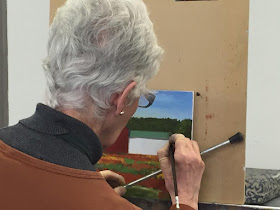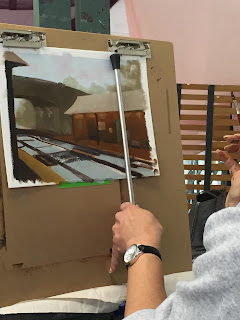It was a lot of fun for me and my class to work together for the two days, which went by fast.
The idea to pitch the class came to me because I know many, many people who love to paint landscapes but for a variety of reasons find painting out doors difficult.
I also know many people paint from photos, so I thought about the strategies I have come to develop and employ when painting en Plein Air that aid me when working from photography, as well as the limits and the benefits of a photo, which are many.
How we see verses how the camera sees, lens distortion, the contrast of photos tends to be greater, the color more intense, what the processing of traditional or digital does to the color verses seeing it with out own eyes. The limit of the position of the camera in that moment, etc. There is a trade off when using photos, and the trick is to not let them or the photo limit you or hem you in, but become a springboard for what you want to paint. An aid, not a crutch.
I do a fair amount of work based on my own photos of subjects I wouldn't be able to paint live on location. So having spent several years doing this I thought I could show students how to use the photos in the right way, to adapt them and ways of working in a classroom setting instead of outdoors.
Now nothing beats being out in nature for your senses as an artist, the sun on you, the sweat, the wind, the smell of the location, the meal you ate, the humidity, bugs, etc. Your sense memory is very essential, vital to pull from when working indoors and using photography, and that is something I stressed first off in the class.I try and remember the feeling of a place I took the photos and imagine myself back there and the conditions of the weather, etc.
Of course one of the biggest arguments that continues to play on like an endless game of badminton or tag is the argument against or for using photography as tool in painting. My students all told me they had been told to,"Never paint from photos!" Of course one man's never is another man's must!
Photos--Bad! If I had a dime for every time I heard that in school I could buy the most expensive camera ever!
This is big art crime in art schools and was something I heard when I was first in college in the early 80's before dropping out, and I still found the same argument going on when I went back to the academy decades later. But at the same time everybody seems to be using pictures to paint from. And lets not even get side tracked by the whole Photorealist movement which started in the late 60's.
Honestly its a very silly and boring argument for me, and one I never heard Illustrators going on about, just mostly "Fine Artists" and those of a certain generation who grew up during Abstract Expressionism. And you hear all kinds of conflicting arguments form all camps in school as a student which my students said they found very confusing. Looking across the vast plain of contemporary art you can see the camera is a tool used by thousands of artists from Eric Fischl, Jenny Saville, Alex Kanevsky and David Hockney to name just a few. My favorite Illustrator Norman Rockwell used photography extensively as a tool and there is a great book on it Norman Rockwell: Behind the Camera. Just using a camera will not make you a Rockwell, that's for sure, there still has only been one of him.
To prepare the class I brought in a lost of paintings to show, paintings done plein air and those from photos and where and why I decided to shoot pictures that sometimes I would not come back to work from as a source for months, even years later. My Commuter Series was a good example where I have done many paintings from photos I took commuting on SEPTA into and out of Philly,
I gave a slide show talk on my laptop to start and next I did a demo for the class working from a photo I snapped in the Brandywine to show how I used the photo and the changes I make, which might be the same ones I would make on location. How the shadows were very dark in the picture but were not in real life, now the computers colors were much more intense and how I could decide which way to push these things as well as adapt what I see into a more pleasing composition. Move or eliminate trees, fences, etc., and in the end what my painting needs to work as a painting that trumps anything in the photo. Every painting is a process of choices, statements and corrections, of memory, even on location, you look at the subject, think and then look away to your canvas to make a stroke---in that few seconds you must use your memory to hold that "thought stroke" as I call it.
I finished up the demo and then we took a lunch break after which I had the students use their photo sources to develop their paintings with sketches first, starting with thumbnails and playing with the compositions. That took most of the rest of the day which ended with the students just starting to paint before the end of the first class. But I feel they got a lot out of the thinking part of the workshop on the first day.
The second day we started off painting again and worked till early afternoon again pausing for a lunch break, I worked a lot with each student as the class size was small, which was nice. By afternoon most had finished their paintings and wanted me to do another demo, which I did and they wanted me to do a night scene.
I choose a scene from 69th Street near my house which was very mysterious and sort of blasted out in parts which i told them allowed me a lot of freedom to interpret and play around and invent.
It started very abstract and I worked explaining my thought process as I moved along. It takes practice to do this two-brain way of working but the class was very good with questions which helped.




In the end the workshop was fun for me and for
the class and went over so well I'll be offering another one in the summer.










nice
ReplyDeletethank you for posting , click here for any help in Shop Drawings Preparation in USA
ReplyDelete